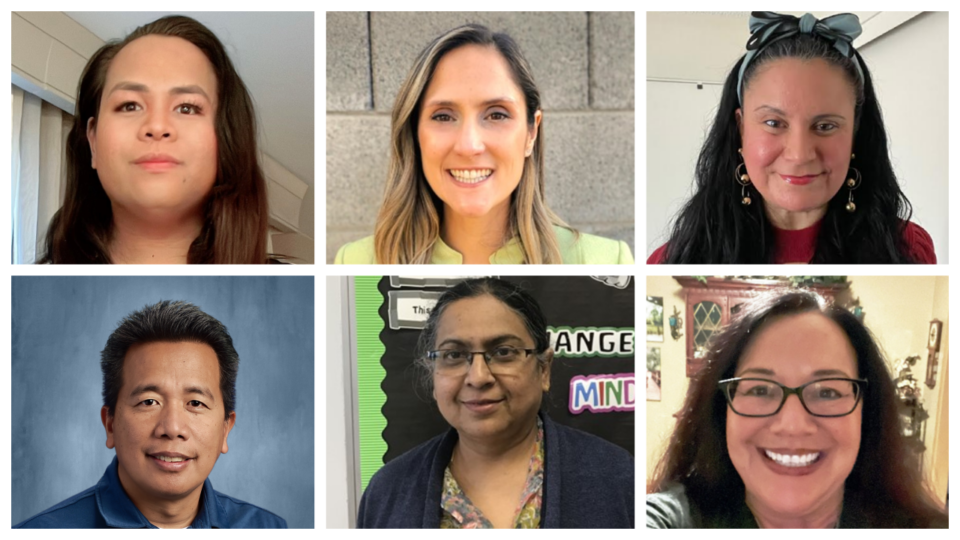2023-2024 Science News Learning Ambassadors
The Science News Learning Ambassadors are educators from across the country who have been inspiring their middle and high school science students with Science News journalism for years! They are Science News Learning expert teachers who want to share their love of teaching science literacy using current, real-life examples with others throughout the school year. Ambassadors partner with program staff to give meaningful feedback and develop new, creative lesson plans using Science News Learning resources and solutions for their own classrooms.
The 2023-2024 Science News Learning Ambassadors collaborated as a cohort during the 2023 High School Research Teachers Conference to set their individual outreach goals and present their use of Science News Learning resources. Ambassadors are also working to develop their own classroom resources using program materials and will implement their new lessons in their 2024 classes. Check out each Ambassador’s journey and favorite resources below!

Karisa Boyer
Karisa is a science and research teacher at Joplin High School in Joplin, Missouri. Karisa has been sharing her passion and strategies for using Science News Learning resources in the classroom for years. She appreciates that the publication helps demonstrate current examples of science research and thinks that it also helps teachers across disciplines demonstrate how important science is in society.
Karisa’s research students have used Science News articles to find project ideas of their own, and they have even connected with local scientists after reading about their research in Science News. Karisa is using the local publicity of her Science News Learning Ambassadorship to emphasize the importance of science both in her school and in the greater Joplin community. She is sharing ideas within her own department and presenting at a number of conferences in 2024.

“I have several different levels of students using this resource. My regular Biology students use it for helping them prepare for the End of Course exam– I utilize it to supplement the current curriculum. My Advanced Biology students choose to take the course and it is mostly a zoology course– Science News has so many weird and exciting stories I can share! Dual Credit Biology students also benefit by the curriculum enhancement. Lastly, my science research students really lean on these at the beginning of the year to help develop their independent project ideas. Additionally, they can use the articles in their scientific literature searches since the official science journal article is linked to the news articles in the magazines.”
Lesson Plans Karisa is Creating:
- A guide for teachers about How to Share Science News Learning.
- An insect adaptation activity where students will learn from examples then build an insect that fits a particular biome.
- A data visualization guide by subject area for STEM and ELA teachers.
Karisa’s Favorite Science News Learning Resources:
Maria Cheryl Diangco
Maria is a science teacher at School for Classics High School in Brooklyn, New York. As a self-proclaimed Science News enthusiast, Maria developed a collection of classroom routines, protocols, and ideas for how to effectively use science journalism in her classroom to engage students and enhance their learning.
Maria uses the program resources with her AP Environmental Science students as well as her ENL (English as a New Language) students. She enjoys sharing her toolkit and the program resources with peers at her school and would like to broaden her outreach to new communities this year.

“As recipients of the Science News Magazines, we are grateful to have access to a wide array of information that helps build the Literacy skills of our students both in content and in Reading Comprehension. I have used several Lessons / Activities that come with some of the articles I have been using. The current articles are so valuable for me because I get to incorporate current information to my curriculum. Articles involving climate change and current environmental issues are very helpful. The data and trends enable students to visualize and analyze information that are very relevant and timely.”
Lesson Plans Maria is Creating:
- An overview of strategies for scaffolding lesson plans to use them for language learners.
- A 5-E instructional model lesson plan on the Science News article “Some leaves in tropical forests may be getting too hot for photosynthesis”.
Maria’s Favorite Science News Learning Resources:
Robert Palmer
Rob is a science teacher at Walter Maginnis High School in Red Wing, Minnesota. Rob uses Science News Learning resources to pique his students’ interest while simultaneously meeting their academic needs. Rob knows that every education setting and classroom is unique and feels that teachers need ideas about how to modify curriculum to best meet the needs of their students.
This year, he is collaborating with colleagues to rework their science curriculum using many Science News Media Group resources. He hopes to write about this curriculum work and his new Science News-based lesson plan in a science education journal. He also plans to present at the 2024 conference for Minnesota teachers.

“My students and I look forward to every issue of Science News. It is a perfect fit for our Unified Science curriculum. Each issue offers content in astronomy, biology, chemistry, ecology, geology, meteorology, oceanography and/or physics which we can either briefly peruse or dive into a deep exploration of. Most of our students also have had limited and/or negative experiences with science so this is one way to pique their interest and give them a science voice.”
Lesson Plans Robert is Creating:
- A checklist to help teachers develop a standards-based lesson plan using articles and curriculum from Science News Learning.
- An activity that gives new spin on student-created graphic tales from Science News articles: All about STEM Comics, called Wild Things: An article type from Science News Explores
